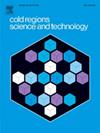Experimental and numerical investigations on the multi-stage creep behavior of frozen sand under stepwise loading and unloading
IF 3.8
2区 工程技术
Q1 ENGINEERING, CIVIL
引用次数: 0
Abstract
As temporary support in geotechnical and tunneling scenarios, frozen soil bodies are often subjected to varying stress states during different construction stages and techniques and, thus, exhibit stepwise loading and unloading, leading to multi-stage creep. However, experimental and numerical investigations on frozen soil creep behavior have focused primarily on monotonic loading, i.e., single-stage creep. This study expands an existing experimental database on stepwise loaded creep and introduces a unique test series focusing on the uniaxial creep behavior of frozen sand under stepwise unloading and load-unload cycles. Here, similar to stepwise loaded creep, the minimum creep rate is found to remain mostly independent of the loading history, while the corresponding frozen soil lifetime depends on the latter. In contrast to equivalent single-stage creep scenarios, the lifetime becomes longer for stepwise loaded creep and shorter for stepwise unloaded creep. To consider multi-stage creep in the geotechnical design of frozen soil bodies, based on our experimental database and literature data, we test the ability of two versions of an advanced constitutive model to capture the frozen soil creep behavior under varying stress states. Comparison of the extended version, called EVPFROZEN, with the original highlights the advantages of EVPFROZEN in consistently capturing the creep rate evolution and the practically important frozen soil lifetime under complex loading histories. Combining the insights from the novel experimental database with testing and validation of the advanced constitutive model EVPFROZEN advances the efficient and sustainable design of frozen soil bodies in geotechnical applications under multi-stage loading conditions.
逐级加卸载条件下冻砂多阶段蠕变特性的试验与数值研究
冻土体作为岩土工程和隧道工程中的临时支护,在不同的施工阶段和施工工艺中,往往受到不同的应力状态,从而表现出阶段性的加载和卸载,导致多阶段蠕变。然而,对冻土蠕变行为的实验和数值研究主要集中在单调加载上,即单阶段蠕变。本研究扩展了已有的逐步加载蠕变实验数据库,并引入了一个独特的试验系列,重点研究了冻砂在逐步卸载和加载-卸载循环下的单轴蠕变行为。这里,与阶梯加载蠕变类似,最小蠕变速率与加载历史基本无关,而相应的冻土寿命则取决于加载历史。与等效的单阶段蠕变情况相比,逐级加载蠕变的寿命更长,逐级卸载蠕变的寿命更短。为了考虑冻土岩土工程设计中的多阶段蠕变,基于我们的实验数据库和文献数据,我们测试了两个版本的高级本构模型在不同应力状态下捕获冻土蠕变行为的能力。将扩展版本EVPFROZEN与原始版本EVPFROZEN进行比较,突出了EVPFROZEN在一致地捕捉复杂加载历史下蠕变速率演变和实际重要的冻土寿命方面的优势。将新的实验数据库与先进的本构模型EVPFROZEN的测试和验证相结合,推进了多级加载条件下岩土工程应用中冻土体的高效和可持续设计。
本文章由计算机程序翻译,如有差异,请以英文原文为准。
求助全文
约1分钟内获得全文
求助全文
来源期刊

Cold Regions Science and Technology
工程技术-地球科学综合
CiteScore
7.40
自引率
12.20%
发文量
209
审稿时长
4.9 months
期刊介绍:
Cold Regions Science and Technology is an international journal dealing with the science and technical problems of cold environments in both the polar regions and more temperate locations. It includes fundamental aspects of cryospheric sciences which have applications for cold regions problems as well as engineering topics which relate to the cryosphere.
Emphasis is given to applied science with broad coverage of the physical and mechanical aspects of ice (including glaciers and sea ice), snow and snow avalanches, ice-water systems, ice-bonded soils and permafrost.
Relevant aspects of Earth science, materials science, offshore and river ice engineering are also of primary interest. These include icing of ships and structures as well as trafficability in cold environments. Technological advances for cold regions in research, development, and engineering practice are relevant to the journal. Theoretical papers must include a detailed discussion of the potential application of the theory to address cold regions problems. The journal serves a wide range of specialists, providing a medium for interdisciplinary communication and a convenient source of reference.
 求助内容:
求助内容: 应助结果提醒方式:
应助结果提醒方式:


